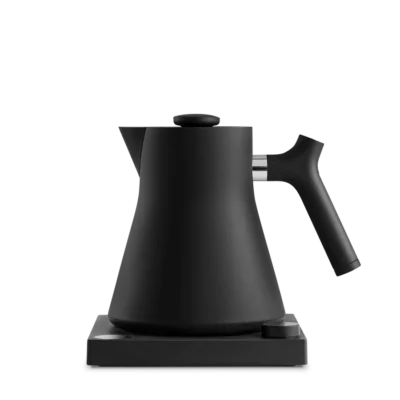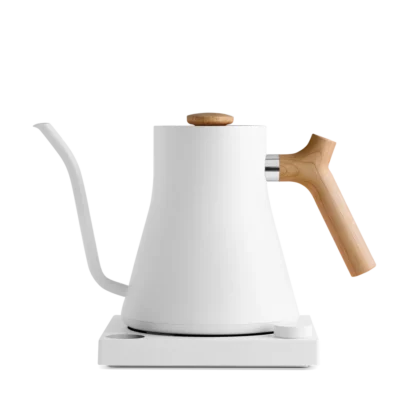We may receive a portion of sales if you purchase a product through a link in this article.
There was a time in my life when I didn’t understand the hype behind an electric kettle. Even in the colder months, Austin’s weather often has me opting for a green smoothie in lieu of a latte or tea. But in the spirit of leveling up all areas of my life and romanticizing even the most mundane moments, warm bevvies—and their inherent coziness—are now a staple in my routine. So of course, this change of heart prompted me to seek out the best of the best electric kettle. Spoiler alert: I’ve been changed for the better.
Like any kitchen appliance, there are a few factors to consider when deciding on the best electric kettle. You’ll need to evaluate what you’ll be using your kettle for, how often, and how much water you’re looking to heat up. (Do you keep to one pour-over or are you a full pot kind of person? Be honest.)
If the hunt seems a bit overwhelming—never fear. We’ve rounded up the best electric kettles for all your warm and cozy needs.

The Best Electric Kettles to Level up Your Morning Routine
This comprehensive list has an electric kettle for just about everyone. From affordable options to luxury splurges, these kettles will make brewing the perfect bev a breeze. With stunning colors, innovative elements, and easy-to-use specs, you’re sure to find your fave.
Our Top Picks:
- Best Electric Kettle Overall: Fellow Corvo EKG Electric Kettle – $165 at Fellow
- Best Basic Electric Kettle: Breville 57oz Soft Top Pure Stainless Steel Electric Kettle – $89.95 at Target
- Best Budget Electric Kettle: Bodum 34oz Electric Bistro Gooseneck Water Kettle – $59.99 at Target
- Best Gooseneck Electric Kettle: Stagg EKG Electric Kettle – $195 at Fellow
- Best Aesthetic Electric Kettle: Alessi Plissé White Electric Kettle – $109 at Care & Barrel
1. Best Electric Kettle Overall: Fellow Corvo EKG Electric Kettle
This is THE electric kettle. Whether you opt for the classic matte black or one of the Wooden Accent models, the Corvo EKG Kettle will be a staple in your morning/evening routine. The kettle keeps heat time to a minimum while still providing exact temperature control. We also love that it isn’t excessively heavy—making pouring your water less of a hassle.
Pros:
- Exact temperature control
- Hold mode to maintain temperature
- Quick heat time
- Minimalist design
Cons:
- No auto shut-off option
- Small volume for the price
Specs:
- Capacity: 0.9 L to max fill line
- Heating element: 1200-watt
2. Best Basic Electric Kettle: Breville 57oz Soft Top Pure Stainless Steel Electric Kettle
If you’re looking for a fairly simple electric kettle to add to your kitchen, this stainless steel kettle from Breville is your best bet. The soft opening lid prevents any hot water spills or splashes and helps to stagger the steam release. Its 360-degree base has concealed storage for the kettle’s cord and a removable scale filter.
Pros:
- Soft top lid gently releases steam and prevents potentially hazardous hot water splashes
- Auto shut-off lid
- BPA free materials
Cons:
- Only sold in stainless steel finish
- Slight discoloration of plastic pieces over time
Specs:
- Capacity: 1.7 L
- Heating element: 1800-watt concealed element
3. Best Budget Electric Kettle: Bodum 34oz Electric Bistro Gooseneck Water Kettle
This slim and stunning appliance is one of the best electric kettles for those looking for a less pricey option. The temperature-controlled gooseneck kettle makes it the perfect addition for all your hot coffee and tea needs while enhancing your aesthetic space. Our Managing Editor, Isabelle has had this kettle for over two years and her love is still going strong. The sleek design is perfect for a small kitchen with limited counter space, and her only qualm is the limited temperature control options.
Pros:
- Back-lit LED display
- Multiple steam vents for stable internal pressure
- Less expensive than other models
Cons:
- Limited temperature control options
- Start button screen is difficult for some users
Specs:
- Capacity: 34 fl oz
- Heating element: 1200-watts
4. Best Gooseneck Electric Kettle: Stagg EKG Electric Kettle
If you’re looking to splurge on any of these kettles, let it be this one. The Stagg kettle features a slim gooseneck spout for perfecting your pour-overs. Additionally, this kettle comes with exact temperature control and a speedy heat time.
Pros:
- Numerous color options + wooden handles
- To-the-degree temperature control
- 60-minute hold mode
Cons:
- Higher price than most electric kettles
- A slow pour from the spout
- Sensitive over-boiling feature
Specs:
- Capacity: 0.9 L
- Heating element: 1200-watt
5. Best Aesthetic Electric Kettle: Alessi Plissé White Electric Kettle
This electric kettle is the perfect pick for the design-oriented. While it leans on the more expensive side, its aesthetic value is worth every penny. Not only is this electric kettle an appliance that you’ll use on the daily, but it’s also one that can be left on display in your kitchen for all to take in its beauty.
Pros:
- Comes in black or white
- Artful and aesthetic design
- Quick boil time
- Cordless
Cons:
- Made entirely from thermoplastic resin
- Lighter and less sturdy compared to models made from heavier materials
Specs:
- Capacity: 57.5 fl oz / 33.8 fl ox
- Heating element: 1500-watt

Other Electric Kettles to Consider
Hearth & Hand™ with Magnolia Cuisinart Cordless Electric Kettle
Convenience meets functionality with this electric kettle from Target’s Hearth & Hand line. For a reasonably priced kettle, this pick has plenty of power at 1500 watts and room to spare with a capacity of 1.7 liters. The 360-degree base connector acts as a cordless power base that takes up minimal room in any kitchen.
Zwilling Enfinigy Cool Touch Kettle
With this kettle from Zwilling, you won’t have to worry about spills when pouring your hot beverage. The outside remains cool to the touch while the double-walled body keeps your drink perfectly hot. This kettle comes in a stunning matte black or stainless steel and holds 51 ounces.
Fellow Clyde Electric Kettle
If you’re after an option that doubles as a countertop centerpiece, this pick from Fellow takes the cake. The kettle features a drip-free pour spout, a heat-resistant handle, and a 1.5-liter capacity and comes in green and black.
KitchenAid ® 1.25-Liter Silver Electric Tea Kettle
Sleek and streamlined, this kettle is the pick for the minimalists among us. Its pared-back exterior aligns with any style and the modern features ensure a perfect cuppa. With a smooth stainless steel body and LED features, it’s the elevated version of the traditional tea kettle we all know and love.

How to Pick an Electric Kettle
There are a couple of important elements to consider when selecting the best electric kettle. As one beverage drinker’s needs may be different than another’s, we’ve laid out the top three things you should consider before making your purchase.
Kettle Capacity
How much water are you planning on heating up? Do you drink several cups of coffee or tea? Capacity is one of the most important factors to take into consideration when choosing your perfect electric kettle. You may want to stick to a capacity of around 1.5-1.7L or more if you’re brewing for 2+ people, whereas you can most likely get by with a capacity of one liter or less if you’re aiming for 1-2 cups of your drink of choice.
Temperature Control and Boiling Speed
If you’re seeking out a kettle that can reach an exact temperature, you may need to opt for a more expensive model. But if you’re simply looking for a kettle that can keep water hot, then you may be able to find a more generic electric kettle.
Additionally, the speed at which water can heat up is a factor to consider in your selection process. If you find yourself short on time (or simply a lack of patience) when brewing your bev, look for a quick-heating electric kettle as opposed to one with a more lengthy heat time.
Selecting Your Spout
How fast or slow your water pours from the electric kettle depends on the spout size and length. If you’re looking for a slower and more precise pour, typically a long, tapered or gooseneck spout is the best option. This can also prevent spills and splashes of hot water that escape from your kettle. If you’d rather have a larger and faster pour, select a spout with a wide and short opening.
















